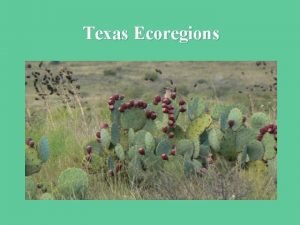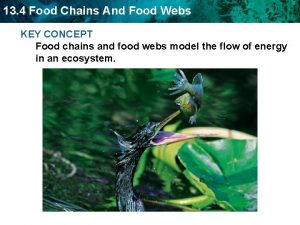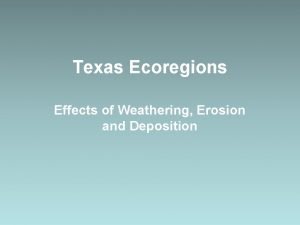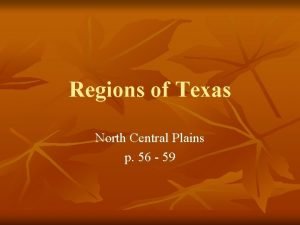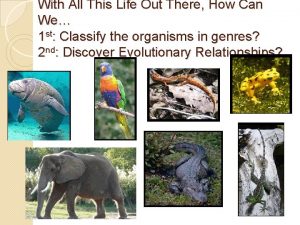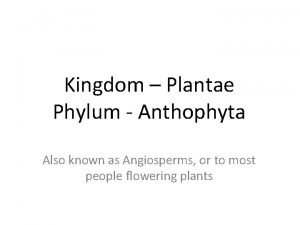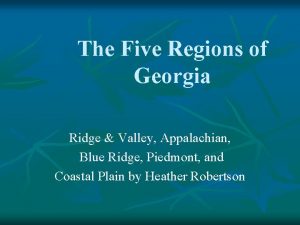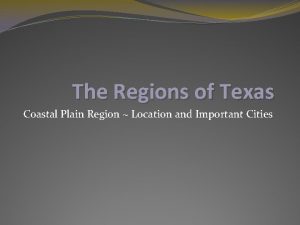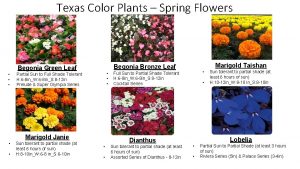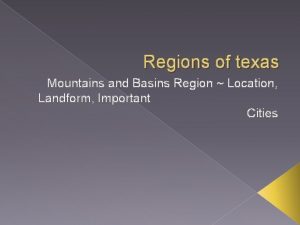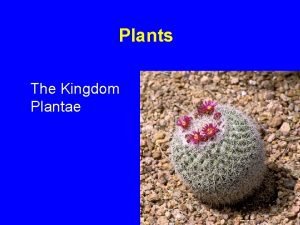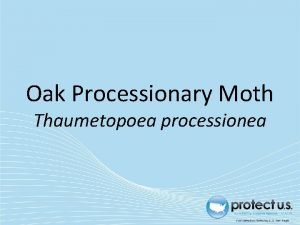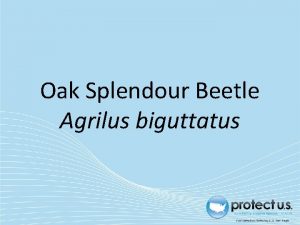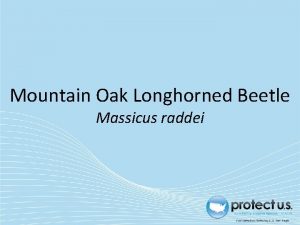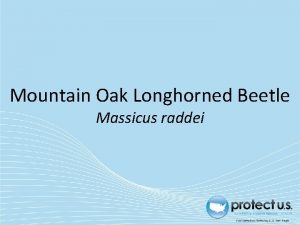TEXAS PLANTS Trees Post Oak Extremely common found


































- Slides: 34

TEXAS PLANTS

Trees • Post Oak • Extremely common, found all over Texas • Reaches an average height of 50 feet

Trees • Live Oak • Extremely common in Texas, used widely in landscaping • Reaches an average height of 50 feet • Characterized by a wide crown often reaching 100 feet

Trees • Shortleaf Pine • Common in East Texas • Reaches a height of 100 feet

Trees • Longleaf Line • Common in East Texas and Central Texas • Can reach a height of 125 feet • The most fire-tolerant species of pine in Texas

Trees • Loblolly Pine • Common in East Texas • Can reach a height of 125 feet • Most often found along the banks of streams and rivers

Trees • Mesquite (invasive species) • Native to Texas, but invasive to other ecoregions, not found in Piney Woods • Can reach a height of 40 feet • Great for BBQ

Trees • Juniper • Most common in central Texas, but can be found in North Texas • Can reach a height of 30 feet • Colloquially called “cedar” trees

Trees • Ash • Common throughout Texas • Can reach a height of 45 feet • Generally found near rocky soil and/or on hillsides

Trees • Acacia • Common in South Texas • Flowers are extremely fragrant, often used in perfumes • Very short, usually maxes out a height of 10 -12 feet

Trees • Bald Cypress • Common in East Texas, they prefer acidic, swampy soils • Can reach a height of 100 feet • Since roots are often submerged in swamp, pneumatophores help aerate the roots

Trees • Cedar Elm • Most common type of elm, widely distributed all over Texas • Can reach a height of 75 feet • Very low maintenance tree, makes it popular for sustainable landscaping

Trees • Mimosa • Invasive species, has naturalized to the Eastern half of the state • Can reach a height of 30 feet • Fragrant, pink, fluffy flowers make this a popular landscape tree

Trees • Southern Magnolia • Native to Southeast Texas • Used in landscaping quite often because of the fragrant flowers • Grow very slowly, about 1 foot per year, it can reach a height of 90 feet

Trees • Pecan Tree • The state tree of Texas • Butter Pecan ice cream was a Texas invention. • Lifespan of up to 300 years! • Pecans are important to Texas industry because they produce the pecan fruit, used in candies, pies, and other foods.

Flowering Plants • Bluebonnet • The bluebonnet is the state flower of Texas • It is NOT illegal to pick them, but if you trespass to pick them, THEN you could face charges • All 5 subspecies of bluebonnets are considered the TX state flower • Bluebonnets bloom in spring from March. May

Flowering Plants • Black Eyed Susan • Low maintenance, fast growing • Bloom from summer to early fall • Black Eyed Susans are considered a pioneer species, and are generally the first flowering plant to grow after a natural disaster

Flowering Plants • Indian Paintbrush • Indian paintbrushes are parasitic plants, attaching their roots to the roots of other plants are stealing their water and nutrients • This is why Indian paintbrushes are often found mixed in with other wildflowers such as bluebonnets • Indian paintbrushes bloom from March-May

Flowering Plants • Mexican Primrose • Extremely hardy flower, loves full sun and infertile soil, making them a perfect flower for acidic, sandy soils with minimal water • Blooms from spring to summer • The flowers bloom in the late afternoon and early evening, giving them another name, the Evening Primrose

Flowering Plants • Sunflower tropisms allow them to follow the movement of the sun to maximize photosynthesis • Very fast growing, can grow up to 12 feet high in less than 6 months • Sunflowers are important to agriculture, clean energy, and the beauty industry, with products of sunflowers being sunflower seeds, sunflower oil, and biofuel

Flowering Plants • Texas Thistle • Often considered a “weed” or pest plant, these spiky, hardy plants serve as a food source for many species in the Hill Country • Blooms from April-July • If left alone- the Texas Thistle can grow up to 5 feet tall!

Flowering Plants • White Prickly Poppy • Mostly found in East Texas, blooms from spring to summer • Toxic to most species of animals, so it’s usually left alone • Was used by Native Americans and Aztecs in traditional herbal medicine- but it must be used carefully and in small amounts, otherwise it could be deadly

Grasses • Texas Grama • Blooms are yellowish brown and blooms from April to November unless mowed • Drought resistant and loves full sun • Prefers sandy soils • Popular choice for planting along highways or large open spaces that need to be low maintenance

Grasses • Texas bluestem • Prefers sandy soils much like grama, and it’s also very drought resistant • Blooms from April to November unless mowed • It’s called bluestem because of the bluegreen tint on the blades, this is due to a slightly higher concentration of chlorophyll a. • Important to ranching, used as a grazing grass for cattle

Grasses • Saltgrass gets its name because it can take up saltwater (such as from the ocean or saltmarshes) and “sweat out” out the salt, they use the remaining freshwater for photosynthesis and the salt crystal form on the blades of the grass • Saltgrass is an important food sources for many species of animals living in coastal regions • Native Americans living near the coast used to scrape the salt crystals off the grass and use it for cooking or trading

Grasses • Buffalo grass is drought resistant and often used as a low maintenance turf grass for government buildings, shopping malls, and parks • Grows very slowly, so little water or food is needed • If not mowed, it can reach a height of almost 12 inches

Grasses • Indiangrass is another great food source and grazing for livestock • Fire-resistant and drought resistant • Because of the pretty red blooms, it is also used in landscaping as an ornamental grass • Tolerates many types of soils

Succulents • Prickly Pear Cactus • The prickly pear is the “state cactus” of Texas, it was almost the state flower, but the Bluebonnet won! • Prickly pear is edible, and often used as an exotic culinary ingredient • Many small rodents build their dens underneath clusters of prickly pear and this offers them protection from predators

Succulents • Yucca • Flowers from the yucca can get quitesome over 20 feet tall! • The sword like leaves are very sharp, meaning most animals do not graze on yucca • Yucca blooms from spring to early summer • Extremely long lifespan- up to 1000 years in the wild

Succulents • Agave lechuguilla • It can take 12 -15 years to amass enough energy to produce blooms on the flowers • Flowers can grow up to 15 feet tall and bloom from May to July • The “heart” of this plant is edible, but must be cooked, otherwise the toxic sap could be deadly

Succulents • Echeveria • Another name for this plant is “Hens and Chicks” • Approximately 100 subspecies exist, differentiated by their coloring • Easy to care for and propagate, making them a popular choice for gardening

Succulents • Agave Americana • Also known as a “Century Plant” since it can take a very long time for it to bloom, sometimes as long as 30 years! • Juice from the plant can be used in many ways, including mescal production and agave nectar. • This plant is slow growing to conserve energy and water.


 Ecoregions of texas
Ecoregions of texas Specialist food web
Specialist food web Which phrase best describes the biosphere
Which phrase best describes the biosphere Gulf coastal plain region
Gulf coastal plain region Piney woods weathering erosion and deposition
Piney woods weathering erosion and deposition Weathering in rolling plains
Weathering in rolling plains North central plains environmental
North central plains environmental Cladogram of five indoor plants
Cladogram of five indoor plants Cell structure diagram labeled
Cell structure diagram labeled I'm a real powerhouse that's plain to see
I'm a real powerhouse that's plain to see Anthophyta reproduction
Anthophyta reproduction Valley and ridge region of georgia animals
Valley and ridge region of georgia animals Vascular plants vs nonvascular plants
Vascular plants vs nonvascular plants Vascular vs nonvascular plants
Vascular vs nonvascular plants Characteristics of flowering and non flowering plants
Characteristics of flowering and non flowering plants C3 plant
C3 plant Where is the gulf coastal plain located on a map
Where is the gulf coastal plain located on a map Texas color plants
Texas color plants Mountains and basins in texas
Mountains and basins in texas Oskar schell character analysis
Oskar schell character analysis Inverted subjects and verbs
Inverted subjects and verbs Cheetahs can run extremely fast because
Cheetahs can run extremely fast because Contains graphic content
Contains graphic content Extremely complex
Extremely complex Extremely
Extremely Extremely
Extremely Lindsey is extremely afraid of becoming obese
Lindsey is extremely afraid of becoming obese Iso 9000 vs 9001
Iso 9000 vs 9001 What is the common ancestor of all plants
What is the common ancestor of all plants Kingdom plantae characteristics
Kingdom plantae characteristics Amanda brown ttu
Amanda brown ttu Texas common app
Texas common app Highest common factor of 12 and 42
Highest common factor of 12 and 42 Common anode and common cathode
Common anode and common cathode Gcf of 48 56 and 72
Gcf of 48 56 and 72
